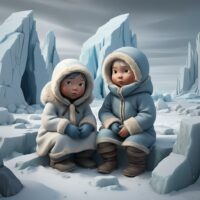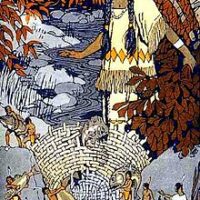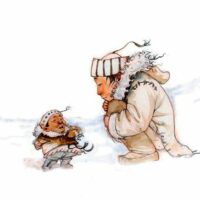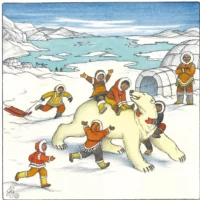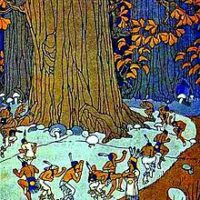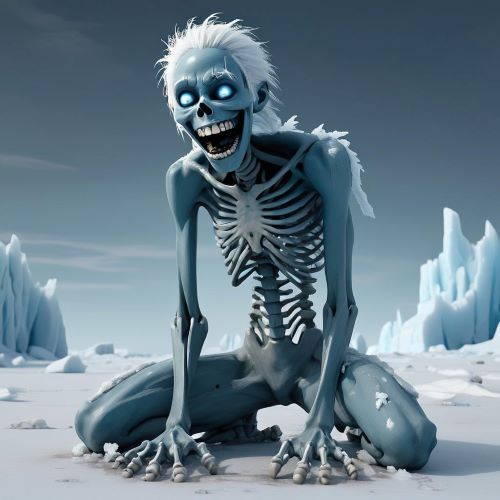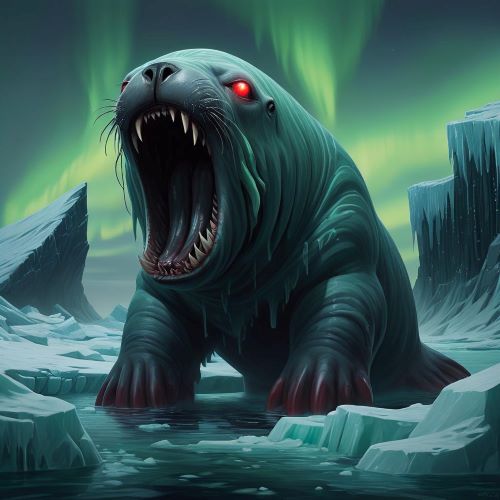Little People : The Mischievous Guardians
Listen
At a glance
| Description | |
|---|---|
| Origin | Inuit Mythology |
| Classification | Spirits |
| Family Members | N/A |
| Region | Greenland, Canada, Alaska |
| Associated With | Shapeshifting |
Little People
Introduction
The Inuit people, from the Arctic regions of North America, Greenland, and Siberia, possess a captivating array of stories, legends, and spiritual beliefs that have shaped their culture for centuries. Central to these narratives are the tales of the Little People, supernatural beings who inhabit the imaginations of the Inuit. These mysterious entities are significant figures in Inuit folklore, symbolizing both the benevolent and mischievous aspects of the supernatural world.
Inuit mythology is intricately woven with stories reflecting the harsh yet beautiful Arctic landscape. Among its most intriguing figures are the Little People, enigmatic beings embodying the spirit of the land and its deep connection to the Inuit. These small, mysterious entities play a crucial role in the Inuit cultural heritage, serving as guardians, tricksters, and reminders of the delicate balance between humans and the natural world. The unforgiving landscape of the Arctic has birthed a rich tapestry of myths and legends, with the Little People standing out as central characters in this fascinating collection.
Physical Traits
Descriptions of the Little People vary across Inuit cultures, reflecting the diversity of the Arctic regions. These beings are primarily characterized by their diminutive stature, often portrayed as no taller than a child and sometimes even smaller. While some accounts describe them as resembling humans, others depict them with animalistic features such as pointed ears, sharp teeth, or furry bodies. Despite their small size, the Little People are said to possess immense strength, allowing them to hunt large animals and perform feats beyond human capabilities.
In Inuit tradition, the Little People are often depicted as shapeshifters, capable of assuming the appearance of animals and inanimate objects, such as caribou, hares, or stones. They are also endowed with the ability to travel extraordinarily long distances quickly, presumably through the use of magic. Known as “Inugarulligaarjuit” or “Inuraraq,” they are portrayed with exaggerated facial features like large eyes and ears, enhancing their senses. Their clothing, typically made from animal skins and fur, helps them blend seamlessly with the rugged terrain of their Arctic environment, further emphasizing their connection to the natural world.
Family
Unlike deities with well-defined family structures, the Little People in Inuit mythology are not typically portrayed as having nuclear families. Instead, they are depicted living in close-knit communities, where elders lead the younger generation. Some narratives suggest they might have a special connection with certain animals, particularly those associated with the Arctic environment, such as polar bears, foxes, and owls.
The concept of family among the Little People is not explicitly defined, but they are often considered part of a broader spiritual family that includes various supernatural beings and spirits. These beings are sometimes thought to be descendants or close relatives of more prominent spirits of the land, sea, and sky. In some traditions, the Little People are believed to live in small communities that mirror the social structures of the Inuit people themselves, emphasizing the interconnectedness of all beings in Inuit belief systems and reinforcing the idea that every creature, no matter how small, has a place and role in the world.
Other names
Known by various names across different Inuit tribes, the Little People embody the diverse cultural landscape of the Arctic regions. In Ojibwe myths, they are referred to as “Memegwaans” or “Memegwaanswag.” In Inuit cultures, they are known by names such as “Tornit” or “Ijiraat,” each carrying unique connotations and stories. These region-specific names vary in pronunciation and spelling, reflecting the linguistic diversity within Inuit communities. Despite these differences, the core characteristics and roles of the Little People remain consistent, underscoring their significance across the Arctic.
The vastness of the Inuit world and the richness of their languages are mirrored in the numerous names given to the Little People. For example, the Inupiat people of Alaska and Northern Canada refer to them as “Tuurit,” meaning “the first people” or “ancestors.” In Nunavut and Labrador, the fearsome Little People are known as “Qallupilluk” or “Qalupalik,” believed to lure children away to their icy homes. In the eastern Canadian Arctic, encounters with “Tuniit” are recounted, depicting them as simple-minded giants or as ancestors of the Inuit, resembling short humans with remarkable strength.
Powers and Abilities
The Little People in Inuit mythology possess a diverse array of captivating abilities that set them apart from humans. Primarily, they are revered as masters of the Arctic, perfectly adapted to the harsh environment of the frozen landscape. With the ability to withstand extreme cold and navigate treacherous terrains effortlessly, they embody the resilience and adaptability necessary for survival in such unforgiving conditions. Moreover, they are believed to possess a mystical connection to the Arctic wilderness, seamlessly blending into their surroundings as they move with agility and grace.
In addition to their physical prowess, the Little People are known for their shape-shifting abilities. Across various stories, they are depicted as capable of transforming into animals native to the Arctic or even mimicking human appearances. This shape-shifting prowess adds an element of mystery and intrigue to their character, allowing them to navigate the natural world with fluidity and adaptability. Their ability to change forms enables them to interact with their environment in ways that defy human understanding, further solidifying their status as enigmatic beings of the Arctic.
Furthermore, the Little People are believed to possess a range of supernatural powers, including the ability to control the weather, heal the sick, and influence the behavior of animals. These magical abilities highlight their deep connection to the spiritual realms and the natural world. While they can be benevolent guardians, offering aid to hunters and protecting travelers, they also exhibit trickster-like qualities, playing pranks on humans and leading them astray. Despite their mischievous nature, they are generally not malevolent, and many Inuit stories emphasize their protective and nurturing side, especially towards those who show respect and understanding of the natural world.
Modern Day Influence
The enduring legacy of the Little People continues to shape and inspire various facets of modern-day Inuit culture. One such aspect is storytelling and artistic expression, where tales of these enigmatic beings are still shared orally, emphasizing the reverence for the natural world and the mystical forces that inhabit it. Artistic representations of the Little People, often depicted in intricate carvings and vibrant drawings, serve as tangible reminders of their presence in Inuit mythology, preserving their significance for future generations.
Moreover, the belief in the Little People serves as a poignant reminder of the interconnectedness of all living beings within the Arctic environment. Inuit communities uphold traditions that seek to avoid disturbing the dwellings of these mythical beings, recognizing their spiritual significance and honoring their place in the natural world. This respect for the environment, intertwined with the lore of the Little People, underscores the profound connection that Indigenous Arctic communities have with their land and the importance of maintaining harmony with nature.
The cultural significance of the Little People extends beyond storytelling and environmental stewardship to encompass tourism and cultural preservation efforts. The allure and mystery surrounding these mythical beings add another layer to the rich cultural heritage of the Inuit. Understanding their stories and the values they represent fosters a deeper appreciation for Inuit traditions and underscores the imperative of preserving their unique way of life. As symbols of the Arctic’s mysterious and magical aspects, the Little People contribute to raising awareness of Inuit mythology and the cultural richness of Arctic peoples, ensuring their heritage endures for generations to come.
Related Images
Frequently Asked Questions
What is lorem Ipsum?
I am text block. Click edit button to change this text. Lorem ipsum dolor sit amet, consectetur adipiscing elit. Ut elit tellus, luctus nec ullamcorper mattis, pulvinar dapibus leo.
What is lorem Ipsum?
I am text block. Click edit button to change this text. Lorem ipsum dolor sit amet, consectetur adipiscing elit. Ut elit tellus, luctus nec ullamcorper mattis, pulvinar dapibus leo.
What is lorem Ipsum?
I am text block. Click edit button to change this text. Lorem ipsum dolor sit amet, consectetur adipiscing elit. Ut elit tellus, luctus nec ullamcorper mattis, pulvinar dapibus leo.
What is lorem Ipsum?
I am text block. Click edit button to change this text. Lorem ipsum dolor sit amet, consectetur adipiscing elit. Ut elit tellus, luctus nec ullamcorper mattis, pulvinar dapibus leo.
What is lorem Ipsum?
I am text block. Click edit button to change this text. Lorem ipsum dolor sit amet, consectetur adipiscing elit. Ut elit tellus, luctus nec ullamcorper mattis, pulvinar dapibus leo.

